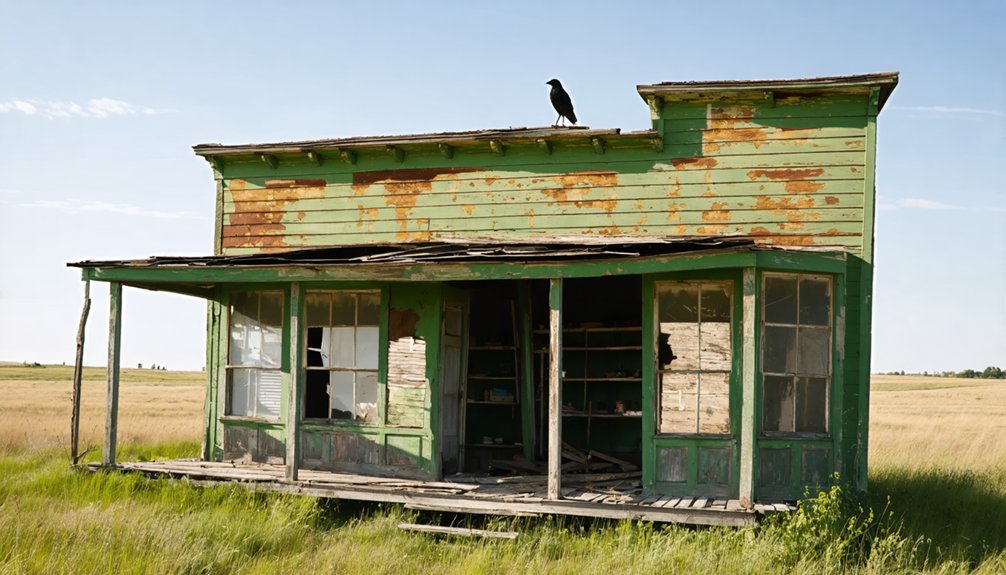You’ll find Stamford’s haunting ruins in South Dakota’s remote plains, where it once thrived as a bustling railroad depot town during the Great Dakota Boom (1878-1887). The abandoned site features crumbling foundations, weathered structures, and remnants of its T-shaped commercial district that served 300 residents at its peak. While exploring requires careful preparation due to unstable structures and isolation, the ghost town’s rich frontier history beckons those seeking to uncover America’s westward expansion.
Key Takeaways
- Stamford emerged during the Great Dakota Boom (1878-1887) and thrived as a railroad town until passenger service ended in 1969.
- The town featured a T-shaped layout with commercial buildings, reaching a peak population of 300 residents.
- Today, only ruins remain, including unstable foundations, partially collapsed structures, and remnants of the former general store.
- The site has no visitor facilities or cell service, requiring careful preparation and safety measures during exploration.
- Located in remote South Dakota, Stamford offers insight into early 20th-century frontier life through its abandoned architecture and graveyard markers.
From Rail Hub to Ghost Town: The Rise and Fall
While railroads transformed much of South Dakota during the Great Dakota Boom of 1878-1887, Stamford emerged as a particularly promising hub along the expanding rail network.
The railroad’s significance quickly turned this strategic location into a bustling center for commerce and transportation. Following typical development patterns, the town adopted a T-shaped layout with commercial buildings lining the main avenue perpendicular to the tracks. You’d have found a thriving depot buzzing with activity as grain, livestock, and manufactured goods moved through the town’s warehouses.
The community transformation was remarkable – schools, banks, and businesses sprouted up to serve the growing population. Like many towns across the state, Stamford relied heavily on branch line service to support local grain elevators and agricultural businesses.
But by the 1950s, you could see the winds of change. As automobiles and trucks gained dominance, rail service declined. When passenger trains made their final stop in 1969, Stamford’s fate was sealed.
Without its railroad lifeline, the once-vibrant hub gradually emptied, leaving behind a ghost town.
Life in Early Stamford: A Railroad Community
During Stamford’s heyday, life revolved around the bustling rail depot that anchored the town’s “T”-shaped layout. You’d find grain elevators and warehouses lining the railroad sidings, while merchants and farmers conducted business along the main commercial street perpendicular to the tracks.
The railroad’s significance extended far beyond transportation. The depot served as the heart of community gatherings, where you’d exchange news and collect mail alongside your neighbors. Like many railroad towns, Stamford’s economic growth potential attracted speculators and investors.
When trains arrived, they brought essential supplies, visitors, and connections to the wider world. With a peak population of 300, Stamford thrived on the mix of railroad workers, merchants, and farming families who depended on the rail line.
The daily rhythm of train schedules shaped everything from business hours to social events, binding the community together through shared routines and opportunities.
Natural Disasters and Economic Struggles
As devastating weather events swept through South Dakota’s plains, Stamford faced a relentless barrage of natural disasters that would ultimately contribute to its decline.
You’d have seen the town’s resilience tested repeatedly through deadly blizzards, destructive tornadoes, and devastating floods that battered the region between 1888 and the mid-1900s.
These natural disasters dealt crushing blows to Stamford’s economic stability:
- The infamous 1888 Schoolhouse Blizzard decimated livestock herds and claimed human lives.
- Recurring floods damaged essential infrastructure and farmland.
- Severe storms destroyed crops and disrupted critical railroad operations.
- Multiple winter disasters forced family relocations and business closures.
Each catastrophic event chipped away at the community’s resources, pushing residents toward more stable regions and accelerating the town’s economic decline through compounded losses and recovery costs. The winter of 1997 proved especially devastating as 50-mph winds created massive snow drifts that completely isolated the remaining population.
Exploring the Ruins Today
When you explore Stamford’s ruins, you’ll need to navigate carefully around unstable foundations and partially collapsed structures while watching for hidden debris and uneven ground.
You can find scattered building foundations throughout the site, including what appear to be remnants of residential homes and a former general store. Like many ghost town sites in South Dakota, the area shows various states of disrepair and abandonment. The boarded up buildings stand as silent reminders of the once-bustling community.
Since the remote location offers no cell service or emergency facilities, it’s crucial to bring safety equipment and explore with a companion while informing others of your planned visit.
Safety During Site Visits
Visiting the ruins of Stamford requires careful planning and strict adherence to safety protocols to prevent accidents and injuries. When undertaking site exploration, you’ll need to prioritize both personal protection and environmental awareness. Always bring essential safety equipment and follow established precautions. Make sure to obtain written permission from property owners before exploring the site.
During your visit, remember these critical safety measures:
- Wear protective gear including sturdy boots, gloves, and a respirator to guard against hazardous materials.
- Explore in groups of three or more, maintaining communication with a trusted contact outside.
- Carry multiple light sources and navigation tools, as cell service may be unreliable.
- Bring a thorough first aid kit and establish clear emergency exit routes.
Before entering any structures, assess their stability and watch for environmental hazards like exposed metal, unstable floors, or wildlife. Take time to visually inspect the exterior of buildings for signs of structural weakness or collapse risk.
Remaining Building Foundations Found
Today’s explorers of Stamford will find primarily building foundations, footings, and scattered ash heaps rather than complete structures.
You’ll need to look carefully, as vegetation often obscures these architectural remnants. The most visible traces are stone and concrete foundations, which outline where homes and businesses once stood in this former mining community.
For foundation preservation purposes, you can match these surviving footprints to historic maps and photographs, revealing Stamford’s original layout. Like many of the over six hundred towns that once dotted the Black Hills, Stamford’s ruins offer fascinating glimpses into its past.
While wooden buildings have long since vanished, their durable stone bases remain as silent witnesses to the town’s bustling past. Natural elements have gradually covered or destroyed many remaining traces of the original settlement.
The architectural significance of these foundations lies in their ability to demonstrate typical late 19th-century construction methods used in South Dakota ghost towns.
Legacy of the Northern Plains Frontier

As the Northern Plains frontier evolved throughout the nineteenth century, it underwent a dramatic transformation that reshaped both the physical landscape and human dynamics of the region. This profound shift in cultural heritage and economic impact continues to echo through ghost towns like Stamford, reflecting the complex interplay between settlement and displacement.
The legacy of this transformation manifests in four key ways:
- The dramatic shift from indigenous buffalo-based economies to agricultural settlements.
- The lasting impact of treaties that redrew territorial boundaries and reshaped communities.
- The emergence of diverse ethnic settlements, particularly Scandinavian and Germanic influences.
- The environmental changes brought by large-scale farming operations that replaced native grasslands.
These changes exemplify how the frontier’s development permanently altered the region’s social fabric, leaving behind both physical remnants and intangible cultural imprints that tell the story of America’s westward expansion.
Visitor’s Guide to the Abandoned Site
The remote ghost town of Stamford, South Dakota offers intrepid explorers a haunting glimpse into early 20th-century frontier life, though reaching the site requires careful preparation and planning.
You’ll need to navigate local roads without major highway access, so bring detailed maps and GPS coordinates. The abandoned architecture tells the story of this former railroad town through its weathered ruins, broken windows, and crumbling foundations.
For your safety, pack water, food, and appropriate gear before exploring the site’s ghost town history.
Watch your step around unstable structures, and stick to nearby hiking trails for safer viewing. While you won’t find visitor facilities or guided tours, you can discover the town’s past through its graveyard markers and remnants of early 1900s railroad life.
Frequently Asked Questions
Are There Any Known Burial Sites or Cemeteries Near Stamford?
While neighboring ghost towns have historic burial grounds, you won’t find documented cemeteries near Stamford. Cemetery history shows regional graves often exist in shared locations like Mount Moriah in Deadwood.
What Indigenous Tribes Originally Inhabited the Land Where Stamford Was Built?
You’ll find that Sioux tribes, particularly the Lakota people, originally inhabited this land. The Oglala band of the Lakota maintained strong cultural and spiritual connections to these western South Dakota plains.
Did Any Notable Outlaws or Historical Figures Ever Visit Stamford?
You won’t find any confirmed outlaw encounters or historical visitors in Stamford’s records. The town’s small size, local lumber focus, and limited documentation show no evidence of notable figures passing through.
Were There Any Documented Paranormal Experiences in Abandoned Stamford Buildings?
You won’t find documented ghost sightings or paranormal investigations in Stamford’s buildings. Unlike other haunting hotspots that draw ghost hunters, historical records and local accounts don’t mention any supernatural activity here.
What Happened to the Town’s Official Records and Historical Documents?
You’ll find most official records were scattered or lost during abandonment. Your historical research might reveal some documents in county courthouses or state archives, though record preservation wasn’t prioritized during Stamford’s decline.
References
- https://en.wikipedia.org/wiki/List_of_ghost_towns_in_South_Dakota
- https://www.atlasobscura.com/places/stamfords-miniature-ghost-town
- https://history.sd.gov/museum/docs/HomesteadingDakota.pdf
- https://www.youtube.com/watch?v=_0WNYsFLSLA
- https://www.sdpb.org/rural-life-and-history/2023-08-21/some-black-hills-ghost-towns-and-their-origins
- https://www.mapquest.com/us/south-dakota/dakota-territory-1880-town-diner-447126253
- http://wikimapia.org/3922796/Stamford-South-Dakota
- https://www.blackhillsbadlands.com/blog/post/old-west-legends-mines-ghost-towns-route-reimagined/
- https://www.sdpb.org/rural-life-and-history/The-Rise-and-Fall-of-the-Railways-in-South-Dakota
- https://www.sdhspress.com/journal/south-dakota-history-5-2/railroads-and-the-settlement-of-south-dakota-during-the-great-dakota-boom-1878-1887/vol-05-no-2-railroads-and-the-settlement-of-south-dakota-during-the-great-dakota-boom-1878-1887.pdf



